Day 1: Monday, Oct 30 6:15pm
Location: Blue Water Marina, Hampton, VA
Weather: Clear skies, wind 17k, 55℉
Dinner: Spaghetti in the new pressure cooker
Four days before the scheduled departure date of November 2nd, our weather router, Chris Parker, declared a favorable weather window, so at 6:15pm our dock neighbors from Arkouda and Blue pushed us off and we were officially underway to Antigua. There are nearly 70 sailboats in the Salty Dawg Rally relying on each other for safety and camaraderie as we make this offshore passage. We’ve listened to lectures, studied weather patterns, and formed friendships with people of all backgrounds. But, we all share one commonality—we love to sail and we all want to trade the snowstorms of the Eastern seashore for a warm, sunny winter in the Caribbean. Here’s our story…written of course from my standpoint as a newbie sailor and chief galley slave…
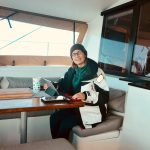 I thought this day would never come. Our ultimate goal, of course, has been to sail. From the time we purchased Gémeaux last December, our time has been spent moving the boat from point A to point B to have this thing modified or that thing repaired…all in preparation for the ultimate sail. So while it was hectic ensuring all those modifications and repairs were indeed working properly, making final phone calls to the kids, picking up last minute groceries, and of course collecting Yann (our French crew) from the airport after many delays, it was with great excitement that we left the lights of civilization behind and finally set off for that ultimate sail.
I thought this day would never come. Our ultimate goal, of course, has been to sail. From the time we purchased Gémeaux last December, our time has been spent moving the boat from point A to point B to have this thing modified or that thing repaired…all in preparation for the ultimate sail. So while it was hectic ensuring all those modifications and repairs were indeed working properly, making final phone calls to the kids, picking up last minute groceries, and of course collecting Yann (our French crew) from the airport after many delays, it was with great excitement that we left the lights of civilization behind and finally set off for that ultimate sail.
 Depending on weather, which dictates everything, we expect it will take 10-18 days to reach Antigua—about 1400 miles (as the crow flies) from our starting point in Hampton, Virginia. This is the longest passage we’ve made, so as much as we prepare and anticipate what that will look like, we really don’t know. As chief galley slave, for example, my goal is to make sure the crew is well-fed and hydrated so they can concentrate on keeping the boat moving south. Normally when we sail, we have a defined end of the day when we anchor, sit down at the table, and enjoy a meal together. On this passage, however, some crew are sleeping, others are at the helm, some don’t feel well, and…there is no end of the day, no anchoring, and certainly no sitting down together. After about six times reheating and dishing up dinner for Allen on this first night, I realized I needed to find a different way to feed everyone. And, I realized that as much as I want the food to taste good, lukewarm mushy spaghetti still fills the belly.
Depending on weather, which dictates everything, we expect it will take 10-18 days to reach Antigua—about 1400 miles (as the crow flies) from our starting point in Hampton, Virginia. This is the longest passage we’ve made, so as much as we prepare and anticipate what that will look like, we really don’t know. As chief galley slave, for example, my goal is to make sure the crew is well-fed and hydrated so they can concentrate on keeping the boat moving south. Normally when we sail, we have a defined end of the day when we anchor, sit down at the table, and enjoy a meal together. On this passage, however, some crew are sleeping, others are at the helm, some don’t feel well, and…there is no end of the day, no anchoring, and certainly no sitting down together. After about six times reheating and dishing up dinner for Allen on this first night, I realized I needed to find a different way to feed everyone. And, I realized that as much as I want the food to taste good, lukewarm mushy spaghetti still fills the belly.
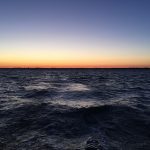 Yann and Jim take the first night watch from 9:00pm to 12:00am. That means Allen should sleep, but in these first few hours aboard, he has way too much energy and wants to make sure everyone and everything is working. He scurries around teaching, checking electronics, tweaking sails, and of course, interpreting weather predictions. Yann is suffering from jet lag so we send him to bed with the promise that he will have plenty of opportunities to stand watch. At the moment, I’m exempt from night watch as long as I keep the bellies full, so I fill the thermoses with coffee and hot water, set out snacks and soups, and crawl into bed with the cat.
Yann and Jim take the first night watch from 9:00pm to 12:00am. That means Allen should sleep, but in these first few hours aboard, he has way too much energy and wants to make sure everyone and everything is working. He scurries around teaching, checking electronics, tweaking sails, and of course, interpreting weather predictions. Yann is suffering from jet lag so we send him to bed with the promise that he will have plenty of opportunities to stand watch. At the moment, I’m exempt from night watch as long as I keep the bellies full, so I fill the thermoses with coffee and hot water, set out snacks and soups, and crawl into bed with the cat.
Even with earplugs, sleep is restless with all the new sounds of being underway—sails changing, the pitching of the boat, and the crashes of water against the bow that sounds like it will split the boat in half. As I get more experienced, I begin to identify the sounds as normal; presently, however, I’m still unsure of that line between normal big ocean water and life-threatening big ocean water. I know better to complain about the restless sleep however—I’m not upstairs in my foul weather gear fighting to stay awake and warm. Thank you, Jim.
Allen relieves Jim at midnight and stands watch until 5am. I lie in bed thankful that Allen has the highest level of energy than anyone I know. He rarely complains—certainly not about something as trivial as cold nighttime temperatures. He enjoys the watches—the celestial skies and often a beautiful moon casting a warm glow across the water. And tonight, more than ever, I imagine he’s enjoying the tranquility and time to process the rush hour of events at departure and all the potential what-ifs of days ahead. At 5am, his head hits the pillow and I’m thankful the man does occasionally sleep.
Day 2: Tuesday, Oct 31 9:30am (Halloween)
Location: NMile 80 off Cape Hatteras
Weather: Clear skies, wind 10k, 73℉
Breakfast: Egg sandwiches, cantaloupe/pineapple
Lunch: Leftover spaghetti and pre-made sandwiches
Dinner: Chicken pot pie and caesar salad
Noteworthy: Dolphins!, Gennaker, entered the Gulf Stream, military practice within earshot
 I woke at 7am in time to witness our first sunrise signaling the end of the night and the beginning of day; it’s difficult, otherwise, to know when day begins since activity continues around the clock on these passages. I’m a little alarmed when I poke my head upstairs to find the helm completely empty. My first thought naturally is Oh my God, we’ve already lost someone overboard! Then, more rationally, I think What a great crew—the captain goes to bed and the crew abandons their post! Of course, neither is true, and instead I find Jim and Yann bundled up on the sun deck with big smiles watching the day break. George, Gémeaux’s autopilot, commands the steering and the crew points out that the sun deck actually affords a better 360 degree view of any freighters or cruise ships on a collision course with us. Who needs fancy radar?
I woke at 7am in time to witness our first sunrise signaling the end of the night and the beginning of day; it’s difficult, otherwise, to know when day begins since activity continues around the clock on these passages. I’m a little alarmed when I poke my head upstairs to find the helm completely empty. My first thought naturally is Oh my God, we’ve already lost someone overboard! Then, more rationally, I think What a great crew—the captain goes to bed and the crew abandons their post! Of course, neither is true, and instead I find Jim and Yann bundled up on the sun deck with big smiles watching the day break. George, Gémeaux’s autopilot, commands the steering and the crew points out that the sun deck actually affords a better 360 degree view of any freighters or cruise ships on a collision course with us. Who needs fancy radar?
The report from the night—winds have been good and we’ve been under sail for about 140 miles. There are also remnants from the nightly feasting so I know the crew is eating and I know which snacks are popular. Good we have a supply of Kind bars and peanuts:)
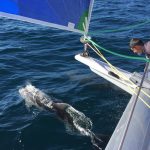 Dolphins! A large pod of 10+ dolphins swim along with us. We’re delighted to be back to the clean, vibrant blue ocean waters where marine life thrives. No matter how your day is going, a dolphin always brings a smile and it’s comforting to know that in this vast body of water, we are not alone.
Dolphins! A large pod of 10+ dolphins swim along with us. We’re delighted to be back to the clean, vibrant blue ocean waters where marine life thrives. No matter how your day is going, a dolphin always brings a smile and it’s comforting to know that in this vast body of water, we are not alone.
Periods of rest, watch, and eat continue for the crew members throughout the day. I nap too, particularly on this first full day of sailing when I don’t quite have my sea legs and the discovery of a strong urine stench in our head turns my stomach. In addition to high levels of energy, Allen also does not suffer from sea sickness so he goes below and moments later the leak in the toilet has been repaired. Once again we have averted disaster.
Securité Securité Securité this is Navy vessel 184. We are conducting live fire exercises in the vicinity of 35.21 North 74.39 West and request all vessels maintain clearance of this area.
We hear this announcement over the radio all afternoon. And wouldn’t you know it, we are indeed in the line of fire. Of all the things that could go wrong on this journey, imagine that we get shot down by our own United States Navy! The Navy does not appear threatened by our little 44-foot sailing vessel, and with a few exchanges over the radio, we confirm we are clear of their target area. Nonetheless, the distant sounds of gunshots are disturbing.
At about 3:30pm, we entered the Gulf Stream. Sadly, there was no white picket fence delineating this notable location in the Atlantic Ocean, but if I had reached my hand overboard I would have noticed about a 15 degree increase to a bath-like water temperature of about 85 degrees. The Gulf Stream also brings strong currents, which we are fighting against in our southeastern passage. So, not only do we need to motor because of light winds, it will take us longer to make any easterly progress until we exit the strong currents of this 40-mile section of the Gulf Stream.
 Just after the sun set and I called dinner, the line on the fishing rod raced off, signaling that my Chicken Pot Pie dinner might be replaced by sushi. In an instant, Gémeaux once again became a fishing boat as Yann successfully pulled in a beautiful 20lb green and blue mahi-mahi. Allen wrestled the critter onto the swim step and cleaned it under the light of a headlamp. The crew graciously agreed to eat the pot pie tonight but tomorrow’s dinner definitely is fresh fish. Night watch begins as Jim takes the helm until midnight, Allen does the midnight-3am shift, and Yann wraps it up with 3-6am. Dot and I are taking the 11pm-7am shift in our cabin that begins…now.
Just after the sun set and I called dinner, the line on the fishing rod raced off, signaling that my Chicken Pot Pie dinner might be replaced by sushi. In an instant, Gémeaux once again became a fishing boat as Yann successfully pulled in a beautiful 20lb green and blue mahi-mahi. Allen wrestled the critter onto the swim step and cleaned it under the light of a headlamp. The crew graciously agreed to eat the pot pie tonight but tomorrow’s dinner definitely is fresh fish. Night watch begins as Jim takes the helm until midnight, Allen does the midnight-3am shift, and Yann wraps it up with 3-6am. Dot and I are taking the 11pm-7am shift in our cabin that begins…now.
Day 3: Wednesday, Nov 1 8am
Location: NMile 200
Weather: Scattered Cum Clouds, Sunny, 75℉
Breakfast: Cream of Wheat-Fresh Fruit
Lunch: Ham-Cheese Sliders and Snap Peas
Dinner: Mahi-mahi, broccoli, and green salad—perfect meal
Noteworthy: Meeting Baloo over VHF, homemade bread in a bag, WIND! and then BIG WIND!
Happy birthday to my niece Sydney and to Dot! Special gift Dot—you get to go sailing nonstop for your birthday week! We’ll give you fresh mahi-mahi for dinner tonight:) Allen reported we exited the Gulf Stream around midnight. Conditions during his 12-3am shift were extremely calm—the water was nearly flat. Well that confirms why I slept so well! It also means we are under power during that entire period. Of course, we cannot cover 1400 miles with the fuel we have aboard so we watch our fuel consumption. Just before 6am while Allen was sleeping soundly, he heard a strap flapping. For me, that persistent tap tap tap just outside my window makes me crazy and no ear plugs are big enough to it out. Allen, on the other hand, sprang out of REM and proclaimed excitedly, “Wind”! And with that, the fuel-burning engines were turned off and we were once again under sail.
 Another gorgeous sunrise—I realize that’s going to be the same report each day:) Morning paper on this passage comes in the form of a 8am weather report from our weather router, Chris Parker, broadcasted from our SSB radio. A weather router, you might ask, is like having your own personal meteorologist. Chris Parker studies the weather patterns off the Eastern seaboard south to the Caribbean. Each day he reports the weather and sailing conditions to us. While it is still the Captain’s decision which route to take, the information we get from Chris is extremely helpful so these 8am reports are never missed. We are also in radio contact with two other sailboats headed for the Caribbean—Katlo (also from the Salty Dawg Rally) and Baloo (from the OCC rally).
Another gorgeous sunrise—I realize that’s going to be the same report each day:) Morning paper on this passage comes in the form of a 8am weather report from our weather router, Chris Parker, broadcasted from our SSB radio. A weather router, you might ask, is like having your own personal meteorologist. Chris Parker studies the weather patterns off the Eastern seaboard south to the Caribbean. Each day he reports the weather and sailing conditions to us. While it is still the Captain’s decision which route to take, the information we get from Chris is extremely helpful so these 8am reports are never missed. We are also in radio contact with two other sailboats headed for the Caribbean—Katlo (also from the Salty Dawg Rally) and Baloo (from the OCC rally).
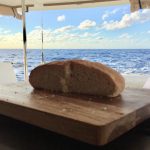
Wind dictates mood. When there’s wind, there’s happiness. And right now late in the afternoon, we are zipping along at 8k so spirits are high. Because I had nothing better to do, I made bread. That makes 2 loaves in my 55 years—I made my first loaf last week:) There are two questions I’ve discovered can immediately engage a woman in the sailing world—what’s your favorite thing to cook on a boat, and do you make bread? Women are tickled to share their absolute best recipes and presto–I have a great collection of sailing recipes! Earlier this week, I met a lovely woman with turquoise blue eyes and a constant smile named Jenevora. Once I learned how to pronounce her name, “Nev” and I were instant friends. She and her husband are from England and also headed for Antigua. She belongs in turquoise waters as far as I’m concerned. Nev gave me a recipe for bread in a bag—no dirty dishes and fresh bread in less than 3 hours. Yum!
And just like that, the wind began picking up and within an hour it was at 17 knots. Books and iPads were put away and we scurried around closing hatches and putting a reef in the mainsail. Of course this all happened just when Allen put the fish on the grill. Everything worked out and we actually were all able to sit down, talk, and enjoy a meal of fresh mahi-mahi together…keeping a tight grip on plates and food. Happy cook! But this rough ride is getting rougher and calls for some Bonine and no more writing. Dot and I are off to bed.
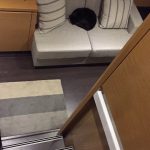 Cat on Cat – By the way, the cat is doing quite well. She’s establishing a routine and her favorite sleep spots—closet in the morning, rug in the afternoon, and sofa in the evening. I never actually see her come to bed but sometime during the night I notice she is there. I think the jump up to the bed on unsteady legs is precarious. She has definitely figured out there is safety in sitting. She walks very gingerly when the boat is rocking and pitching and looks a little bit like a drunken sailor.
Cat on Cat – By the way, the cat is doing quite well. She’s establishing a routine and her favorite sleep spots—closet in the morning, rug in the afternoon, and sofa in the evening. I never actually see her come to bed but sometime during the night I notice she is there. I think the jump up to the bed on unsteady legs is precarious. She has definitely figured out there is safety in sitting. She walks very gingerly when the boat is rocking and pitching and looks a little bit like a drunken sailor.
Day 4: Thursday, Nov 2 9am
Location: NMile 364
Weather: Broken dark clouds with cool wind 72℉
Breakfast: Toast and Fruit
Lunch: Baked Chili yum!
Dinner: Fresh Grilled (and Sushimi) Bonita and Rice Pilaf
Noteworthy: Another fish!, brief squalls, radio exchanges with Baloo, ⅓ of the journey complete
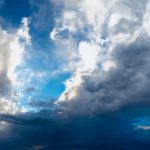 Salty Dawg boats are underway today! Wonder what that looks like—about 70 boats leaving the harbor! Happy birthday sister Collene! Good morning after 12 hours of being in bed! It was hard to fall asleep at 8pm last night but I knew that’s what I needed or I would be at the back of the boat losing dinner. Through the night, wind and current fought each other from opposite directions with Gémeaux caught in the middle. This confluence of weather created a corkscrew affect on the boat causing Gémeaux to pitch and roll so much I thought I would be tossed from bed. As I listened to the swell toss her stern high in the air and then slam her back down in the water, I continue to be astonished that this 45-foot fiberglass structure can withstand the seas. She’s a good girl.
Salty Dawg boats are underway today! Wonder what that looks like—about 70 boats leaving the harbor! Happy birthday sister Collene! Good morning after 12 hours of being in bed! It was hard to fall asleep at 8pm last night but I knew that’s what I needed or I would be at the back of the boat losing dinner. Through the night, wind and current fought each other from opposite directions with Gémeaux caught in the middle. This confluence of weather created a corkscrew affect on the boat causing Gémeaux to pitch and roll so much I thought I would be tossed from bed. As I listened to the swell toss her stern high in the air and then slam her back down in the water, I continue to be astonished that this 45-foot fiberglass structure can withstand the seas. She’s a good girl.
Allen reported just as he started his midnight shift a squall with winds peaking at 27k and an approaching freighter came together in a perfect storm. He reefed the jib and altered our course to avoid the 800-foot freighter. New rule—radar is ALWAYS on at night since you can’t see the incoming squall in the dark and we know the gigantic freighters don’t see us!
Winds eventually subsided and we motored a little in the early morning hours, but we’re definitely cognizant of our relatively low supply of fuel so we sail whenever possible, even very slowly in light winds. After a quick survey, Allen determined there’s water in the bilge, which, I’m learning, is not a really big deal unless it’s a really big amount of water. Allen cleaned it up since, again, he seems to be the only one on our crew who can work down below, particularly on nasty projects, without getting sea sick. Some salt crystals on port side and not enough water on starboard to worry about. He’s not worried, I’m not worried. After the bilge cleanup, Allen continued his trouble-shooting on where the port engine oil leak is coming from. That remains a mystery. It would be more than a month later before we would discover a broken seal.
We continued throughout the day with light to moderate winds. We braced for a few squalls but nothing too bad. We are in to regular radio contact with Bob and Ann on Baloo who are about 30 miles ahead. In addition to just the general companionship out here is this big blue sea, they report any incoming weather, which is a real treat. Speaking of contact, we really enjoy the occasional emails or text messages coming in on inReach from various friends and family. Technology is truly amazing.
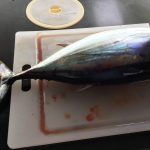 Consistent with our timing for catching fish, the rod screamed its buzzing alert just as I served hot chili for lunch. This time, Allen and Yann pulled in about a 10-lb Bonita—like a small tuna. I was thinking, as chief galley slave, I really should be in charge of filleting the fish. I suppose I’m spoiled just opening the package from Costco, but the smell of fresh fish is too great a trigger for sea sickness. Instead, I serve as sous-chef, handing Allen the knives and cutting board and standing watch as he filets one end of the fish on the board, while the other end hangs over the counter. Once the initial filleting is completed, I’m happy to take back the reins and prepare it for dinner.
Consistent with our timing for catching fish, the rod screamed its buzzing alert just as I served hot chili for lunch. This time, Allen and Yann pulled in about a 10-lb Bonita—like a small tuna. I was thinking, as chief galley slave, I really should be in charge of filleting the fish. I suppose I’m spoiled just opening the package from Costco, but the smell of fresh fish is too great a trigger for sea sickness. Instead, I serve as sous-chef, handing Allen the knives and cutting board and standing watch as he filets one end of the fish on the board, while the other end hangs over the counter. Once the initial filleting is completed, I’m happy to take back the reins and prepare it for dinner.
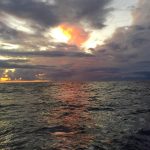 We enjoyed another dinner together, complete with a beautiful sunset. As I was preparing dinner, I noticed an orange glow outside. I raced outside and discovered the setting sun was peaking through the clouds just enough to cast its orange glow clear across the water. It was magnificent. For dessert, we were presented a spectacular moonbow, a white rainbow created by the full moon. That was a first for all of us. I’ve started my Book Club book Small Great Things and consider it great progress that I can read onboard without getting sea sick. It’s a nice way to stay connected with my friends back home, knowing they are entranced in the same story.
We enjoyed another dinner together, complete with a beautiful sunset. As I was preparing dinner, I noticed an orange glow outside. I raced outside and discovered the setting sun was peaking through the clouds just enough to cast its orange glow clear across the water. It was magnificent. For dessert, we were presented a spectacular moonbow, a white rainbow created by the full moon. That was a first for all of us. I’ve started my Book Club book Small Great Things and consider it great progress that I can read onboard without getting sea sick. It’s a nice way to stay connected with my friends back home, knowing they are entranced in the same story.
Day 5: Friday, Nov 3
Location: NMile 500
Weather: Broken dark clouds with cool wind 74℉
Breakfast: Toast and Fresh Fruit
Lunch: Sandwiches
Dinner: Grilled Mahi-mahi and Big Green Salad
Noteworthy: Sailboats on the horizon!, mahi-mahi, still wind!
I can’t stand the smell of myself any longer so I broke down and took a shower. Even though we have a water maker, we’re always conserving water just in case the water maker fails. Boat showers, by the way, are military showers—water on to get wet, water off to lather, and water on to rinse. Done in less than 60 seconds. My son, Nick, who loves long, hot showers, would struggle:)
There are boats on the horizon! After four days of nothing but blue sea and the occasional distant freighter, we can see two sailboats on the horizon. By exchanging GPS coordinates, we determined one is Baloo and the other is Kinetik, (Lisa and Andy on an Outbound46 ) another boat in the OCC rally with Baloo. There’s also Navigator, who we haven’t had a visual on but appears occasionally on our Automatic Identification System (AIS) that shows all vessels in the area. It’s ironic—one of the reasons we enjoy sailing is to escape civilization; yet, on this day we are rejoicing in seeing a bit of it.
Gémeaux Gémeaux this is Baloo on 16
This is Gémeaux let’s switch to 68
And with that, we leave Channel 16, the universal monitoring channel, dial up to Channel 68, and a friendship ensues. Radio transmissions begin with cordial exchanges of weather and sailing strategies. First names are exchanged shortly thereafter and we are now Allen and Ann exchanging backgrounds and stories. And then at midnight, exchanges are made between fellow night watchers to break up the monotony and again, just to know there’s another soul out there. We have no idea what each other looks like. By the time we reach Antigua, we will all be long-time friends.
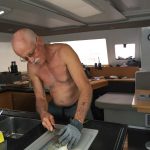 We sat down for lunch and…you guessed it—zzzzzzzzzz…the line took off and minutes later we had another mahi mahi. I’m retracting my statement about not filleting fish—I really should know how to do this. So, after a quick lesson from Allen, who by the way, admits that he’s not an expert, I took a stab (ha!) at it. Let’s just say I need a lot more practice and probably sharper knives too.
We sat down for lunch and…you guessed it—zzzzzzzzzz…the line took off and minutes later we had another mahi mahi. I’m retracting my statement about not filleting fish—I really should know how to do this. So, after a quick lesson from Allen, who by the way, admits that he’s not an expert, I took a stab (ha!) at it. Let’s just say I need a lot more practice and probably sharper knives too. 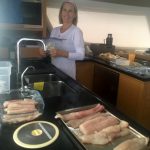 They make it look so easy in the you-tube videos! Anyway, grilled fish on the menu tonight. P.S. we caught another mahi-mahi an hour later…just afterJim finished sharpening the knives so he tried his hand at filleting and went straight to the head of the class. I’m happy to report we now have a fish filleter aboard.
They make it look so easy in the you-tube videos! Anyway, grilled fish on the menu tonight. P.S. we caught another mahi-mahi an hour later…just afterJim finished sharpening the knives so he tried his hand at filleting and went straight to the head of the class. I’m happy to report we now have a fish filleter aboard.
Day 6: Saturday, Nov 4
Location: NMile 637
Weather: Scattered clouds and 74℉
Breakfast: Toast-Fresh Fruit-Soft Boiled Eggs
Lunch: Grilled Ham and Cheese Sandwiches
Dinner: Miso Soup and Teriyaki Chicken-Pork Bowls
Noteworthy: flying fish on the deck, 20+ dolphins swimming with us, scrubbed the decks
Allen was attacked last night during his watch…a flying fish landed right on his foot while at the helm. Recall that our freeboard (distance between the water and our deck) is 7 feet, add another foot to reach the helm, and that’s quite an acrobatic feat for the little guy. You’ll be glad to know that he did not become friends with the mahi-mahi in our fridge and was safely returned to his home. We sailed through the night with 10-12 knots of wind. Still trying to make easterly progress while we have wind. Wind was mostly light during the day around 8k but we sailed even though most of our progress is south.
 While the captain rested, his industrious crew scrubbed the decks. This is quite an undertaking relying on sea water and a single bucket. Note to self: purchase an additional bucket. Even though we’re traveling relatively slow at 4k, dipping the bucket overboard attached with a 4-foot rope still nearly takes your hand off when the water finally catches in the pail. We gave the young strong Yann that job. Our boat is now the most sparkly around….well, she’s the only boat around at the moment. We’ve lost sight of Baloo and Kinetik, which means soon we’ll lose radio contact as well when they drift out of our 20-mile range.
While the captain rested, his industrious crew scrubbed the decks. This is quite an undertaking relying on sea water and a single bucket. Note to self: purchase an additional bucket. Even though we’re traveling relatively slow at 4k, dipping the bucket overboard attached with a 4-foot rope still nearly takes your hand off when the water finally catches in the pail. We gave the young strong Yann that job. Our boat is now the most sparkly around….well, she’s the only boat around at the moment. We’ve lost sight of Baloo and Kinetik, which means soon we’ll lose radio contact as well when they drift out of our 20-mile range.
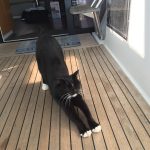 Cat on Cat – spending less time in the closet! Still mostly sleeping, as cats will do, but at least on a rug or sofa. She seems to be getting her sea legs. We wonder what she must think of all the endless motion with not a speck of land in sight. We’re learning from Dot and rest whenever possible.
Cat on Cat – spending less time in the closet! Still mostly sleeping, as cats will do, but at least on a rug or sofa. She seems to be getting her sea legs. We wonder what she must think of all the endless motion with not a speck of land in sight. We’re learning from Dot and rest whenever possible.
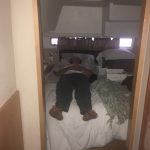 Dinner calls…miso soup embellished with fresh tuna sashimi appetizer, followed by chicken teriyaki. I asked for a temporary respite from fishing so we could eat some of those well-prepared meals that are consuming freezer space. Turns out we all prefer the fresh fish over mushy rice…duh. Dinner is cleaned up, thermoses are filled, snacks replenished, and night watches begin.
Dinner calls…miso soup embellished with fresh tuna sashimi appetizer, followed by chicken teriyaki. I asked for a temporary respite from fishing so we could eat some of those well-prepared meals that are consuming freezer space. Turns out we all prefer the fresh fish over mushy rice…duh. Dinner is cleaned up, thermoses are filled, snacks replenished, and night watches begin.
Day 7: Sunday, Nov 5
Location: NMile 753
Weather: Scattered clouds and breezy, 75℉
Breakfast: The last of the blackberries, toast, and yogurt
Lunch: Tomato Soup and Quesadillas
Dinner: Pork Tenderloin and Wedge Salad
Noteworthy: Mutiny!, routing-routing-routing!, still searching for the promise land, ignoring DST
The night before we were attacked by flying fish; last night there was mutiny. While the Captain was down below sleeping, the night crew rebelled and set a new course. “Why,” the crew wondered, “would we sail north if our destination is south? We have such a dumb captain.” And with that, the crew adjusted the sails and rejoiced in their wisdom as we began a southerly route. The captain, of course, sleeps with one eye closed and the other on his iPhone, which has remote access to the chart plotter from the comfort of his cozy bed. No sneaking around here.
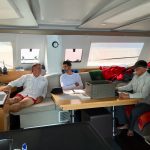 In the morning, the Captain explained his rationale for his northeastern strategy to gain as much easterly progress as possible, even at the expense of backtracking north. In the spirit of teamwork, however—and the fact that we gained only 30 easterly miles of our 80 miles and are presently back to the same latitude this morning as we were last night—the Captain relented and we continued a southeastern route. Suffice it to say, progress is slow. This is what a slow day looks like—social hour in the salon and an empty helm.
In the morning, the Captain explained his rationale for his northeastern strategy to gain as much easterly progress as possible, even at the expense of backtracking north. In the spirit of teamwork, however—and the fact that we gained only 30 easterly miles of our 80 miles and are presently back to the same latitude this morning as we were last night—the Captain relented and we continued a southeastern route. Suffice it to say, progress is slow. This is what a slow day looks like—social hour in the salon and an empty helm.
A lot of tardy slips were given on the shift changes last night when Daylight Savings time kicked in at 2am and everyone’s iPhone alarms were automatically adjusted. Antigua doesn’t recognize DST so we override the auto feature of our phones and ignore it as well.
I remember when I lived in Denmark I laughed how the day’s events were planned around the meals. In the morning, we would wake up and talk about when we would have lunch and what we would eat. Once that was determined, we could plan out the activities of the morning and squeeze in additional events in the afternoon when lunch was completed. If we were lucky, we would have enough time for something fun before dinner prep began. It’s a little like that on this passage, especially when days are slow. We’ll have our books and iPads out enjoying quiet time, or some of the night shift crew will be napping. Seas are relatively stable at the moment so there isn’t much to oversee at the helm. Around 11:30, I’ll ask Allen, “Feel like some lunch?” His eyes light up like a kid who’s just been asked if he wants to go to the candy store. I suppose with no Facebook, TV, or phone calls, and just a great pool of blue to look at, a meal IS rather like an event. Note that eating because we’re actually hungry is entirely a different subject, as we seem to expend little physical energy to build a true appetite.
So, what do we eat? When we first started sailing, meals were special occasions and I tended to fix several side dishes for a single meal or add bacon to breakfast. We realized quickly that if we continued that pattern, we would no longer fit on the boat. We decided to eat more simply like we do at home. Of course, we can’t run to Costco or Safeway when we feel like making a leg of lamb, but then again we can catch fresh fish without leaving home. And with a lot of planning, we have an array of prepared meals and meats in the freezer and a refrigerator filled with fruits and veggies. On this 7th day of passage, I notice the supply of perishables is dwindling and soon we’ll be eating more potatoes and pantry items. I have a celebratory meals of steaks and frozen asparagus (we love fresh asparagus) hidden away for our last night at sea.
A flicker of nostalgia as I recall I was married on this day 29 years ago. It’s been eight years since my divorce, a devastating time when I was sure life would never be the same. Thankfully, it’s not. My heart is filled with love for a man that shares my sense of adventure and love of our planet. Life’s a journey. A spectacular sunset…really, I need to come up with some more adjectives to describe these sunrises and sunsets.
Day 8: Monday, Nov 6
Location: NMile 901
Weather: High thin cirrus clouds, 76℉, humid
Breakfast: Cream of wheat, fresh blueberries, toast
Lunch: Leftover pork tenderloin
Dinner: Beef barley stew and hot bread
Noteworthy: Laundry!, dry bilges, SWIMMING!, Chartreuse, a day of motoring
We motored about 90 miles through the night to the east. Well not actually east, and not southeast, or south of east, but rather east southeast at 112 degrees. Does anyone else find this humorous?
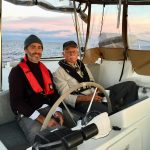
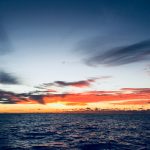 At 6:20 this morning when I noticed a soft orange glow creep into our berth, I leapt out of bed and raced past Jim and Yann at the helm to the bow of the boat to witness another beautiful start of the day. I know to our readers, the sunrises and sunsets blend together and okay, they’re all beautiful. But truly, each one is unique and they are simply breathtaking. I realize they’re pretty much the only thing that breaks the monochromatic canvas of blue so of course we’re excited about them.
At 6:20 this morning when I noticed a soft orange glow creep into our berth, I leapt out of bed and raced past Jim and Yann at the helm to the bow of the boat to witness another beautiful start of the day. I know to our readers, the sunrises and sunsets blend together and okay, they’re all beautiful. But truly, each one is unique and they are simply breathtaking. I realize they’re pretty much the only thing that breaks the monochromatic canvas of blue so of course we’re excited about them.
I went to bed expecting the night to be rough since we planned to head right into that east wind. Instead, the seas were relatively calm and I slept like a baby. When the water isn’t smashing against the hulls, that continuous rocking motion beats any sleep aid.
Since we’re running the engines, we once again replenished our fresh water supply with the onboard water maker that converts salt water to fresh. The water maker requires a lot of electricity, which is best made from our engines. We love this luxury of making our own water, particularly when we are far from civilization for an extended time. The Captain estimates we’re using about 30 gallons of water each day—mostly a function of dish washing, two toilets with electric flushing, and the occasional shower. We could engage the ultra-conservation mode but, for the moment, the water maker is keeping up so we all appreciate each other showering.
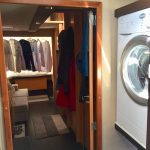 Speaking of luxuries, on this 8th day of passage, we also do some laundry…in a washing machine! Our washer/dryer combination is indeed the ultimate luxury, and I’m grateful for it, especially the time it saves us at port when we don’t have to hang out at the laundromat.
Speaking of luxuries, on this 8th day of passage, we also do some laundry…in a washing machine! Our washer/dryer combination is indeed the ultimate luxury, and I’m grateful for it, especially the time it saves us at port when we don’t have to hang out at the laundromat.  The machine is powered by the generator, however, which is also a fuel hog, so laundry day will be very quick and we skip the dry cycle—on this warm day with all the hatches open, clothes dry quick when they’re hung. Allen gets into the domestic duties as well with needle and thread and a device made especially for driving the needle through the thick canvas. We spied a cruise ship on the horizon. I imagine those passengers are having a slightly different day than we are…no Bingo on Gémeaux:) By the way, do you like my office?
The machine is powered by the generator, however, which is also a fuel hog, so laundry day will be very quick and we skip the dry cycle—on this warm day with all the hatches open, clothes dry quick when they’re hung. Allen gets into the domestic duties as well with needle and thread and a device made especially for driving the needle through the thick canvas. We spied a cruise ship on the horizon. I imagine those passengers are having a slightly different day than we are…no Bingo on Gémeaux:) By the way, do you like my office?
And then, when this great big sea was sleepy calm in about 7000 feet of water, I had a therapy session to overcome my fear of deep water. I went swimming! We had slowed the boat down to take some drone photos against another beautiful sky and it seemed the perfect opportunity…and Allen promised not to sail off without me:) The color of the water was a rich cobalt blue and perfectly clear—the beauty in itself distracted me from any fears. We each took a quick dip and laughed at the thought of swimming in the middle of the Atlantic Ocean. And, of course, we got some more great drone photos.

Swimming in the Atlantic–notice how small I am. When I saw this photo, it reminded me just how difficult it would be to find someone if they fell overboard. I decided to try my best to stay on the boat.
After much discussion over the past few days about the English word, sundowner, Yann served us a shot of Chartreuse that he brought from France. “It’s made from many many plants,” Yann explained, so it must be healthy and we must drink it:) Yum—perfect accompaniment to the end of the day.
Day 9: Tuesday, Nov 7
Location: NMile 1090
Weather: Afternoon clouds and scattered showers, 70℉
Breakfast: Toast, still fresh pineapple!
Lunch: Niçoise salad without lettuce and Mac & Cheese
Dinner: Fish tacos
Noteworthy: Under sail again! No leaking oil in the port engine
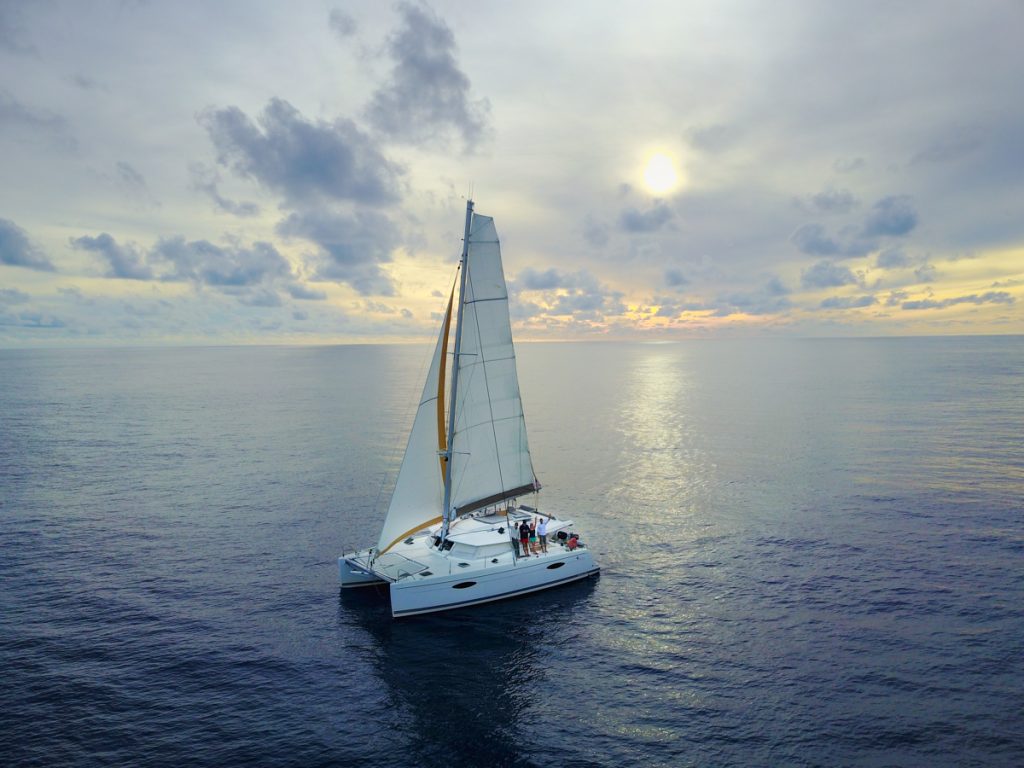 At 3am, watch ended and the Captain slid into bed. The glow of the iPhone reminded me that he is still monitoring our course and wind. Minutes later, he’s up again and I hear the steady roar of the engines replaced by the creaks and moans of the boat twisting in the waves. We are sailing again. He crawls back into bed and reports that the wind picked up and we can make the same speed under sail and not waste fuel. I ask which direction we’re going, expecting an answer of east southeast or southeast or… “The right direction,” he replies and falls into slumber.
At 3am, watch ended and the Captain slid into bed. The glow of the iPhone reminded me that he is still monitoring our course and wind. Minutes later, he’s up again and I hear the steady roar of the engines replaced by the creaks and moans of the boat twisting in the waves. We are sailing again. He crawls back into bed and reports that the wind picked up and we can make the same speed under sail and not waste fuel. I ask which direction we’re going, expecting an answer of east southeast or southeast or… “The right direction,” he replies and falls into slumber.
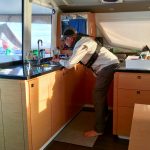 Proper Galley Positioning: by Jim Moore—The majority of boat injuries occur in the galley, making it the most dangerous place on the vessel. As the boat pitches and rolls, one must take special care to avoid bodily contact with a pot of boiling water or a flying pan. Jim demonstrates how to make his famous bullet-proof coffee by first placing the cup in a holding bin in the sink. Next, he wedges his backside into the aft counter, thereby locking his body into a sturdy, stationary position. He is now free to navigate the hot water in his cup, properly whisking the butter and coffee together to produce the perfect morning java. Wearing a life vest during this operation is not necessary but highly recommended.
Proper Galley Positioning: by Jim Moore—The majority of boat injuries occur in the galley, making it the most dangerous place on the vessel. As the boat pitches and rolls, one must take special care to avoid bodily contact with a pot of boiling water or a flying pan. Jim demonstrates how to make his famous bullet-proof coffee by first placing the cup in a holding bin in the sink. Next, he wedges his backside into the aft counter, thereby locking his body into a sturdy, stationary position. He is now free to navigate the hot water in his cup, properly whisking the butter and coffee together to produce the perfect morning java. Wearing a life vest during this operation is not necessary but highly recommended.
 Big day for Yann—we taught him how to make Kraft macaroni and cheese…and then we made him eat it! It was difficult convincing him that the packet of orange powder was cheese:) Speaking of highly nutritious sustenance, our Captain is rejoicing in the surprise stash of Diet Coke that I had tucked away at port.
Big day for Yann—we taught him how to make Kraft macaroni and cheese…and then we made him eat it! It was difficult convincing him that the packet of orange powder was cheese:) Speaking of highly nutritious sustenance, our Captain is rejoicing in the surprise stash of Diet Coke that I had tucked away at port.
When I wrote the book, Survival Through Laughter, about my experience with breast cancer, a friend asked me, “Why didn’t you write about the bad things that happened? Your entire story sounds way too optimistic.”I told her that by writing a positive message kept positive momentum moving forward and that was the key to survival. But the comment stuck with me and I realized over time that I simply don’t write when things are going really bad—those are the times I’m huddled under the covers of my bed wishing the world away. Eventually, the storm passes and I get out of bed and find my pen.
I wondered if our readers were curious about the same thing on this journey? In all honesty, there are few bad things; otherwise, I wouldn’t be on it. The biggest thing that sends me under the covers of my bed, is sea sickness. So let’s start there. I did wonder when this idea of living aboard a boat first took hold, “What if I’m sea sick all the time?” Allen could stand on his head while sailing and never get sick. I, on the other hand, have little experience on a boat and it didn’t take long before I realized this could be a deal breaker. I’ve wretched on my hands and knees over the stern of the boat, turned green when a fish is being filleted in the galley while underway, and spent many many hours watching that damn horizon with the wind blowing on my face, praying for the nausea to go away. Sea sickness is awful. Fortunately, I have a hearty supply of Bonine and I usually get my sea legs after a few days of being underway.
Boat smells. I’ve been cursed with an extra-sensitive, acute sense of smell. I smell everything and that often leads to the aforementioned sea sickness. I purchased gallons of fragrance-free hand soap, experimented with air fresheners, eliminated scented garbage bags, even installed new plumbing in the heads—there is still a boat smell. If anyone can figure out what it is and how to eliminate it, you’ll be my savior.
Lack of exercise. There’s plenty of strength required to manage sails, scrub the decks, etc., and just by maintaining your balance with every step must strengthen your abs. But honestly, unless we swim behind the boat, it’s hard to get any cardio in. I miss hiking and yoga and the structure of gym workouts to keep me fit. I do love my 7-minute NYT workout app on my phone but often I’m not motivated, particularly on a moving boat when tree pose might just send me overboard.
I know there are more things…I’ll be back.
Day 10: Wednesday, Nov 8
Location: NMile 1176
Weather: Broken clouds and 76℉
Breakfast: Toast and 4 blueberries…per person
Lunch: Deli meats-cheeses, homemade ciabatta
Dinner: The final gigantic veggie salad and baked potatoes
Noteworthy: Mourning the loss of SiriusXM radio at 24N, morning dead calm to night SQUALLS!
Lest you think I write this entire blog by myself, I should disclose my sources. As you know, there is no Google oracle out here in the middle of the Atlantic, and sadly, our handy iPhone weather app doesn’t work either. We must use our actual brains to answer questions such as—How many miles have we come? Or, what is the temperature today? Or, how deep is the ocean here? Okay, we do have electronics, and anybody who knows Allen or Jim knows that we have ALL the electronics that are available to mankind, and often we have a duplicate or a backup or a different color or…Nonetheless, this exercise of using brainpower instead of the keypad on our iPhone is a good one, and one that I wish all teenagers, er, people, would do occasionally to make sure our frontal lobes are still functional.
Back to my sources. Each day, I begin my report with an update on our location and weather. Source #1 is the Captain who reports our mile marker. The fact that he asks me to remind him what he reported the day before makes me a little suspect of his answer but I figure it’s close enough. Source #2 is Jim Moore who reports the wea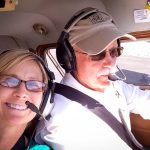 ther. I selected Jim for this critical piece of information because of his aviation experience, which we all know requires a solid foundation of weather knowledge…and because he can wear a zip tie like no other. As long as I’ve known Jim, whether he’s flying his plane or hiking or just having a glass of wine, he can always report whether the clouds are cumulus or cirrus, broken or scattered. My friend, Kristen Henry, and I would say, “This is Jim’s gift.”
ther. I selected Jim for this critical piece of information because of his aviation experience, which we all know requires a solid foundation of weather knowledge…and because he can wear a zip tie like no other. As long as I’ve known Jim, whether he’s flying his plane or hiking or just having a glass of wine, he can always report whether the clouds are cumulus or cirrus, broken or scattered. My friend, Kristen Henry, and I would say, “This is Jim’s gift.”
 However, and this is a big however, Jim himself often will admit that after a long, drawn-out scientific explanation of whatever question I’ve posed, he’ll pause and say, “Of course, that could just be MSU.” I always enjoy Jim’s answers to life’s questions, so even if he is Making Shit Up, I’m entertained and typically believe his answer…until I can get home and fact check him with Google.
However, and this is a big however, Jim himself often will admit that after a long, drawn-out scientific explanation of whatever question I’ve posed, he’ll pause and say, “Of course, that could just be MSU.” I always enjoy Jim’s answers to life’s questions, so even if he is Making Shit Up, I’m entertained and typically believe his answer…until I can get home and fact check him with Google.
Since Jim’s weather report today couldn’t fit succinctly on a single line, I decided his thoughtful response earned an entire paragraph. It went like this when I asked, “Hey Jim, how would you describe the weather today?”
“The cloud cover is broken to overcast and the temperature is 77℉. I’d say the water temperature is 73.4℉,” Jim reports. Except for that silly remark about the water temperature, I buy the rest of his report. “What about the ever-important wind?” I ask.
“The wind is south of east southeast or 110 degrees. Actually,” he reflects further, “It would be north of east southeast. Or you could say it’s two points south of east.” Oh good, thanks for that additional clarification—it makes it much clearer. Then I go out on a limb to really test the reliability of my source. “Jim, what’s the dew point?”
“The dew point must be about 68,” Jim reports confidently. I can tell he’s surprised that I would have even thought to ask the question. I probe deeper, “And you know his how…?”
“Well, you would use a hydrometer. I think that’s what it’s called,” he admits a possible infraction in his reporting, but continues on. “A hydrometer has two thermometers associated with it—one is the wet bulb thermometer and the other is a dry bulb thermometer. The wet bulb is like a piece of wet fabric so it’s always wet. If the air is dry, then the moisture around the wet bulb thermometer evaporates quickly and cools that temperature….” Lalalalalala…my mind drifts off, wondering how my bread is rising. “Okay Jim, I got it.”
Just then, the sun peeks out from behind a cloud so I ask, “What about the sun?” “The sun is very much involved in the temperature,” he laughs that Jim Moore laugh that we all love. You decide what’s MSU in Jim’s report today but don’t you have a much better sense of how I stay constantly entertained?:)
As we listen to Chris Parkers’ daily weather report and learn that the promise land of trade winds has moved yet again from latitude 25 North to 24 North, Yann declares in his accented English, “It is like a carrot, you know. It is here in front of you but when you get near to it, the carrot moves again and you do not ever get to the carrot.” Couldn’t have said it better myself. Damn carrot.
 We alternate between sailing when the winds reach 10k and motoring when the wind subsides and/or we need to make more easterly progress. This is what our boat looks like when there’s no wind. But just when we get cocky and stop resting, rain strikes. Squalls continued through the night. A day of mourning. We’ve officially lost our Satellite XM radio, which apparently declares a latitude of 25 North to be the end of its US broadcast.
We alternate between sailing when the winds reach 10k and motoring when the wind subsides and/or we need to make more easterly progress. This is what our boat looks like when there’s no wind. But just when we get cocky and stop resting, rain strikes. Squalls continued through the night. A day of mourning. We’ve officially lost our Satellite XM radio, which apparently declares a latitude of 25 North to be the end of its US broadcast.
Day 11: Thursday, Nov 9
Location: NMile 1289
Weather: Scattered clouds, unlimited visibility, squalls east
Breakfast: Egg sandwiches, cereal, and souring milk:(
Lunch: Tomato soup and quesadillas—a favorite
Dinner: Costco Chicken Alfredo, stretching veggies for a green salad
Noteworthy: SQUALLS become squalls, 355 miles away from Antigua!
Today will be a day of many naps. Squalls with hard rain and winds peaking at 24k kept all the night shifts busy. I lied in bed during Allen’s 3-hour shift last night listening to size 17 feet running around above my head and the constant violent banging on the water hitting the hulls. 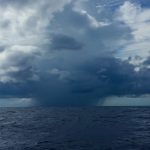 Large rogue waves struck the center of the hulls, jarring me from any possibility of sleep. Gémeaux creaked and moaned as though she was crying from all the abuse:( Later, I asked Allen if boats ever break from the constant pounding of water. “No, not really,” he reported, and I decided that’s all the answer I needed and didn’t want to explore the not really part.
Large rogue waves struck the center of the hulls, jarring me from any possibility of sleep. Gémeaux creaked and moaned as though she was crying from all the abuse:( Later, I asked Allen if boats ever break from the constant pounding of water. “No, not really,” he reported, and I decided that’s all the answer I needed and didn’t want to explore the not really part.
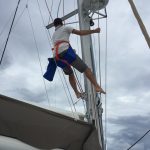 About mid-morning, we found a cotter pin on the deck. Hmmm…wonder where that came from? Cotter pins are those slightly useful things that are used to secure important boat parts to make sure they don’t come unscrewed–important parts like the mast! Allen’s first thought was that it must have fallen from the mast since it was on the deck.
About mid-morning, we found a cotter pin on the deck. Hmmm…wonder where that came from? Cotter pins are those slightly useful things that are used to secure important boat parts to make sure they don’t come unscrewed–important parts like the mast! Allen’s first thought was that it must have fallen from the mast since it was on the deck. 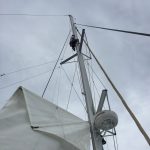 So, up the mast Yann went. He poked around in all the likely places but there was no sign of missing parts. And, even though winds were light, we were in the middle of the Atlantic Ocean so we decided Yann’s time on the mast should be short and we pulled him back down to safety. Mystery unsolved and hopefully not critical to our safe passage. Later, we would have a formal survey done at the marina and still find no explanation for the errant pin.
So, up the mast Yann went. He poked around in all the likely places but there was no sign of missing parts. And, even though winds were light, we were in the middle of the Atlantic Ocean so we decided Yann’s time on the mast should be short and we pulled him back down to safety. Mystery unsolved and hopefully not critical to our safe passage. Later, we would have a formal survey done at the marina and still find no explanation for the errant pin.
Day 12: Friday, Nov 10
Location: Mile 1445
Weather: Scattered clouds, 16-25k of wind
Breakfast: Toast and Final Pineapple
Lunch: ? (they’re all running together)
Dinner: Costco Chicken Tamale Bake and green salad
Noteworthy: More flying fish, winds died after squalls, final piece of pineapple, and a LEAK!!
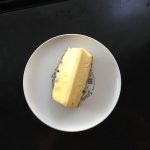 We thought the biggest news of the day was Allen’s final piece of fresh pineapple. And then, we discovered a leak…
We thought the biggest news of the day was Allen’s final piece of fresh pineapple. And then, we discovered a leak…
Just after dinner, I went downstairs and noticed a small pool of water on the floor near our bathroom. I thought it was a peculiar place for water so I moved some things out of the way and quickly discovered an inch of water had accumulated on the shelf under the emergency hatch. As I knelt down for a closer look, a wave hit the hatch and I was horrified when I actually felt spray on my face. I knew we had a problem.
I called Allen immediately and asked if he could see where the leak was. Until this point, I had only witnessed leaks so slow it’s difficult to find the actual source of the leak. Now, however, we discovered the pane was protruding outward from its frame creating about an ⅛” gap between the top of the pane and the frame. I’ll never forget Allen’s next words—“I’m not afraid of the leak; I’m worried the whole panel is going to fall out.” For the first time, I was afraid.
There are two emergency escape hatches on Gémeaux—one on either side in the forward berths. The hatches are there for escape in the event the boat capsizes. They are located just below the water line so in perfectly calm conditions the water is just below the bottom of the hatch. Underway, when seas are rough, the waves splash across the entire pane, pretty much submerging the window. Last month, we replaced the port hatch after several failed attempts to seal a leak. Until now, we hadn’t had any trouble with the starboard hatch.
The first thing we did was attach the suction cups we use to lift up the floor panels to the glass pane in order to create as much inward suction. Allen stopped the boat to minimize the amount of force the waves were striking the hatch and also to lower the level at which the water was penetrating the window. I sat with Jim, who was holding the suction cup on the pane, fearing any moment the pane would fall out into the sea and we’d have gallons of water flooding our berth. I got our life jackets and began contemplating an evacuation. While the guys were brainstorming around the hatch, I quietly began putting together passports and wondering how Dot would survive an evacuation.
We radioed Pratique, the boat we had been in contact over the past few days, who was about 10 miles ahead. Allen reported to them that we weren’t in imminent danger at the moment; however, we had an underwater hatch that had failed and water was coming in. “Not in imminent danger?”, I thought, “We’re going to sink! We need help right now!” Allen calmly told them we would be in touch shortly with an update. Pratique stopped their boat and promised to stand by until further notice. It was a great relief to know another boat was nearby. Later we would learn that as soon as Pratique got our call, they turned their boat around. Sailors are such great people:)
Reflecting on the entire experience 24 hours later, I can see that this calm, level-headed nature is what makes Allen a superior problem solver. Of course, he knew more—like the boat would not fill with water and actually sink, given the way a catamaran is constructed with two hulls. (We’re still discussing that theory, however.) Even if we did need to evacuate, we had a life raft and a dinghy and nearby boats and the Coast Guard could provide assistance. I didn’t have benefit of that information until the entire episode was over, as we were all focused on the task at hand. I felt nauseous and realized it was not sea sickness, but instead worry that sat like a pit in my stomach.
With the boat slowed down, we could get a better look at the problem and discussed a variety of solutions—putting adhesive around the edge of the window but how would the adhesive hold and can we apply it in wet conditions?—drilling a hole in the window and through a piece of wood to hold the window inward drilling? really? um, that’s a hole in a boat…We also enlisted Pratique’s crew of four to brainstorm and talk through the pros and cons of each option, particularly the option that required drilling a hole in the plexiglass. Did anyone have experience with this? What are the odds of the glass shattering? Is there a sacrificial hatch we could experiment on? This entire drilling option was so scary to me—there seemed to be a lot of risk in making the situation worse. At least now we had a window and not a gaping hole.
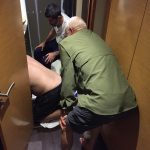 Our berth was transformed into a work site—the box labeled Adhesives rested on the floor. Rags, paper towels, a bucket, and sponges were strewn about sopping up water. Then, the drill appeared, along with the box labeled Nuts and Bolts. There was a lot of poking fun at me a month ago when I methodically sorted and labeled this mess of supplies; nobody was poking fun today. The floor was reminiscent of a scene from the Apollo 13 movie when the engineers were given a table full of bits and pieces to find a make-shift solution to eliminate the carbon dioxide problem in the space shuttle. I wasn’t encouraged when Allen picked up the first tube of adhesive and asked Yann to translate the French directions. Yann replied, “This is not adhesive, it is what you use to not have bugs.” Great, insecticide is just what we need.
Our berth was transformed into a work site—the box labeled Adhesives rested on the floor. Rags, paper towels, a bucket, and sponges were strewn about sopping up water. Then, the drill appeared, along with the box labeled Nuts and Bolts. There was a lot of poking fun at me a month ago when I methodically sorted and labeled this mess of supplies; nobody was poking fun today. The floor was reminiscent of a scene from the Apollo 13 movie when the engineers were given a table full of bits and pieces to find a make-shift solution to eliminate the carbon dioxide problem in the space shuttle. I wasn’t encouraged when Allen picked up the first tube of adhesive and asked Yann to translate the French directions. Yann replied, “This is not adhesive, it is what you use to not have bugs.” Great, insecticide is just what we need.
No matter what the solution, one thing was certain—somebody needed to look at the situation from the outside and see if the window could be pushed back into its frame. This, of course, was a job for the Captain. We unleashed the dinghy from a jungle of lines that secured it for our open water passage; after all, who needs a dinghy in the middle of the ocean? If there’s one thing that immediately shows you how rough the seas are, it’s when you put a dinghy in the water and watch it pitch and roll with every wave. It’s about 9pm and pitch black. Once we managed to get Allen into the dinghy, he had to lie flat on his back on the bottom of the boat to avoid ramming his head into the top of the boat each time a wave surged. We ran a line from the bow to the stern attached to either end of the dinghy to keep it positioned just outside the hatch and not float off into oblivion. Who would have guessed our newly-installed underwater lights were not just an aesthetic enhancement.
Once underneath the boat, Allen clearly could see that the top of the glass panel was protruding out from its frame. With only a 10” clearance between the dinghy and the bottom of Gémeaux, Allen popped his head up just enough to see the hatch and with the heel of his hand thrust a single slam to push the window pane back into its frame. If only that was all that needed to be done.
Thankful that now at least we had closed the gap and water was no longer spraying into the boat, we retrieved Allen from the dinghy and discussed next steps to stabilize the window. I was relieved when we finally concluded that we should first try an adhesive before drilling into the glass. Most adhesives must be applied to a dry surface and require time to cure. We had one small tube of epoxy putty that could be applied to a wet surface. Not only did we have a small amount of the epoxy, but it was fast-drying and would set in only 5 minutes. We would need to work fast. Our strategy: set up our work space inside near the hatch; GENTLY push the panel out again to create a space for the adhesives, (this was extremely frightening given the risk of pushing the panel completely out); launch Allen back under the boat in the dinghy; and then Jim, Yann, and I would quickly prepare and place the epoxy around the perimeter of the window; and finally, Allen would push the window in again hoping for a better seal.
We launched Allen again underneath the boat. Jim set a timer for 5 minutes. We divided the epoxy into three sections and each of us kneaded the putty until it was pliable enough to roll into three long strands. Of course nothing is as easy as it sounds—the adhesive cracked and broke as we rolled it with our hands and three long strands turned into many small odd-shaped bits and pieces. Nonetheless, as the timer neared five minutes, Yann rapidly placed the epoxy strips around the edge of the panel. Allen pounded the frame back into position and later told us he could see the epoxy spread throughout the edges of the hatch and frame as he pounded—a sign we got a good seal. But was it enough, particularly when the force of the water begins to pound the window when we get underway? For good measure, we put another layer of sealant adhesive around the inside edge of the glass.
It was 1am. We agreed to maximize the amount of time for the adhesive to set, so we remained in a drifting state of less than 1 knot through the night rather than pressing on. We would decide in the morning if we should put in place anything else to stabilize the window. We released Pratique and told them to go on—there were other boats that would be within range shortly. Before going to bed, Allen placed a call to the U.S. Coast Guard in Puerto Rico to report our situation so they would have all the information about our boat in case we needed additional support. The call took about an hour and included setting off our EPIRB emergency GPS locater to confirm that the Coast Guard could read our location. We promised to check in at first light when we expected to get underway.
At 2am, we all went to bed for four hours of rest. No night watch since we were in a drift mode and there was little to monitor. Allen set an alarm on the chart plotter to sound if any vessels came within a 10-mile radius. After all this, it would be just our luck to get run over by a freighter. I already had drafted the following update for the family before our crisis occurred. We decided for the moment, a report of another happy day at sea was the best report…
Note to Fam: We were steaming along last night and then this morning those darn squalls diverted the trade winds so we had slow going today. Had flying fish on the deck; other than that, our cat, Dot, is our only “wildlife.” Starting to really feel the humidity of the Caribbean—less time in the berths and more naps on the top deck. Have one final romaine heart that we’ve stretched into three green salads with some frozen and canned veggies. Allen mourned the final piece of pineapple. Who knew the day would unfold so differently?
Day 13: Saturday, Nov 11
Location: Mile 1577
Weather: Sunny with scattered clouds, humid, 75℉
Breakfast: Toast
Lunch: Grilled Ham and Cheese
Dinner: Grilled Chicken and Orzo w Carrots and Onions
Noteworthy: All eyes on the leaking hatch! a school of dolphins
I slept fitfully with worry. Meanwhile, as soon as Allen’s head hit the pillow, his problem-solving mind kicked into gear. At 5:30am, I noticed lights were on upstairs and heard the sound of sawing. Allen noticed I was awake and said with excitement, “While I was sleeping, I came up with this great idea for the hatch.” Of course he did—the man whose mind never rests.

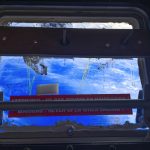 His idea was instead of drilling a hole in the glass, we would use contact cement to affix blocks between the window pane and a larger piece of wood the width of the hatch, and use long bolts to leverage the blocks against the frame to prevent the hatch from pulling out. Allen was busily sawing little blocks of plastic and wood. I think we were all a little relieved to have a solution that didn’t involve drilling into the glass. With the blocks in place, we crossed our fingers and got underway.
His idea was instead of drilling a hole in the glass, we would use contact cement to affix blocks between the window pane and a larger piece of wood the width of the hatch, and use long bolts to leverage the blocks against the frame to prevent the hatch from pulling out. Allen was busily sawing little blocks of plastic and wood. I think we were all a little relieved to have a solution that didn’t involve drilling into the glass. With the blocks in place, we crossed our fingers and got underway.
Normal watch was embellished to include hatch watch to check the seal on the hatch. For the first few minutes under sail, I sat next to the hatch and cringed each time a big wave slammed into the glass, still convinced the window would blast away. After a short while, we could see water was still penetrating the glass but it was a small, slow, and steady leak that we could sponge up every 15-30 minutes.
In the daily 8am group weather chat, Pratique explained our situation to the other vessels so now all nearby boats were aware. Soon, we received a radio call from Aladdin, a sailboat in our rally who was 20 miles back and who would remain at our side checking in on the hour. By this time, Allen had struck up a friendship with the US Coast Guard, sending photos of our repair and exchanging weather information—good friends to have in my opinion.
Anxious as we were to reach land, we determined a lower speed would reduce the pressure of the water striking the vulnerable glass. Ironically, we had perfect winds blowing about 17 knots that would have made for a fabulous sail into Antigua. Instead, we reefed the sails and maintained our speed at 5-6k.
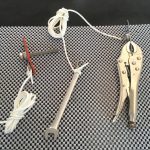 My stomach in knots, I ate nothing but Pringles to satisfy that insatiable craving for salt. Recognizing my anxiety, Jim put together backup plans B, C, and D and laid out all the tools and equipment necessary in case we needed to move quickly. Allen took me down to study the hatch and how the repairs were holding. A rainbow appeared on the horizon, a school of dolphins swam alongside, and Allen put on my favorite Neil Diamond playlist. I fell into a much-needed sleep. When I awoke, I once again felt confident in Gémeaux and ready to put this behind me as just another hurdle in the boating life. The rest of the day was consumed with talk revisiting our perils and successes last night and telling tales of the sea.
My stomach in knots, I ate nothing but Pringles to satisfy that insatiable craving for salt. Recognizing my anxiety, Jim put together backup plans B, C, and D and laid out all the tools and equipment necessary in case we needed to move quickly. Allen took me down to study the hatch and how the repairs were holding. A rainbow appeared on the horizon, a school of dolphins swam alongside, and Allen put on my favorite Neil Diamond playlist. I fell into a much-needed sleep. When I awoke, I once again felt confident in Gémeaux and ready to put this behind me as just another hurdle in the boating life. The rest of the day was consumed with talk revisiting our perils and successes last night and telling tales of the sea.
On this final night of sailing, I decided to take a night watch with Allen. Sensing that Allen really needed rest, Yann and Jim extended their watch so Allen’s shift was only 2-1/2 hours. I sat at the helm with Allen, doing hatch check every 30 minutes and making tea and soup. Aladdin came into view a couple miles back with its red navigation light breaking up the darkness of the night. A waning orange moon rose on the horizon providing a little light, but the sky remained dark and the stars were brilliant as usual. My favorite constellation, Orion, shone brightly—we had chased it all the way down this 1400-mile southern journey.
The hatch repair appeared to be holding and we were making steady progress so we crafted the following update to our family that would convey our safety.
Note to Fam: We were making good progress last night as we were preparing for the night watches. I noticed water leaking from a hatch at the waterline. We stopped the boat and the MacGyvers sprang into action. In a scene reminiscent of the Apollo 13 movie, when the engineers were given a table filled with parts to determine a solution, our crew spread out a variety of epoxies and sealants and finally repaired the leak with waterproof epoxy. We waited until morning to resume sailing so the epoxy could cure. Come morning, we dreamed up new solutions to further strengthen the hatch and continued on our way at a reduced speed. We expect to arrive in Antigua Sunday night. After a much needed glass of champagne, replacing the hatch will be our top priority!
Day 14: Saturday, Nov 12
Location: Mile 1659 (obviously not a straight line)
Weather: Sunny with scattered clouds, humid, 75℉
Breakfast: Soft boiled eggs
Lunch: Pupu platter of ham, cheese, and crackers
Dinner: Steaks and champagne
Noteworthy: LAND HO!
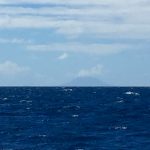
 At 10:15am, the glorious sight of land came into view. “Land ho,” Allen exclaimed. Antigua lay just ahead. I checked the hatch and placed a bottle of champagne in the refrigerator.
At 10:15am, the glorious sight of land came into view. “Land ho,” Allen exclaimed. Antigua lay just ahead. I checked the hatch and placed a bottle of champagne in the refrigerator.
Yann reeled in first a barracuda and then a small Bonita—both were returned safely to the sea…of course. The crew became giddy with excitement as we neared land and we all were maintaining positions at the helm or on the sundeck to soak in the sight of land.
We motored into Jolly Harbor just before 4pm as Customs was closing. We were tickled to see Baloo in the harbor and took a mooring ball just next to them. Bob and Anne rode up in their dinghy just as we were enjoying a champagne toast on the sundeck. They joined us in the celebration and it was delightful to hear their stories and journeys from their home state of Washington.
Tomorrow we would clear customs and re-enter civilization. For now, we enjoyed a steak dinner (without holding onto our plates) and a beautiful night of rest in quiet seas.
Enjoyed this post?
Sign up to receive email notifications of future posts!

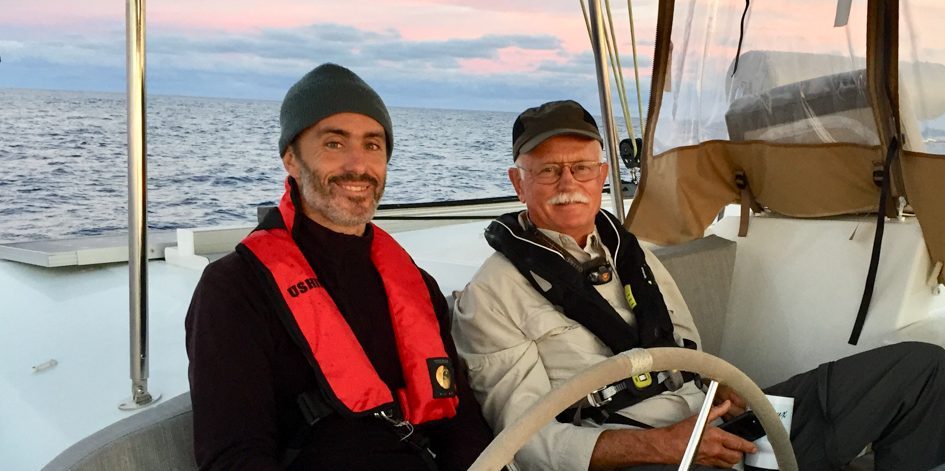
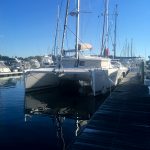
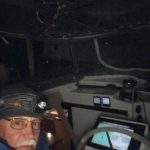
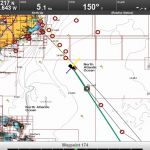
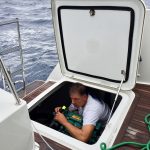
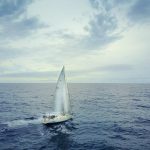
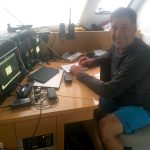
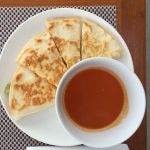
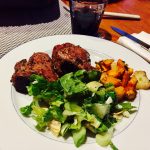
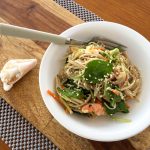

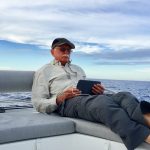
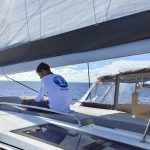

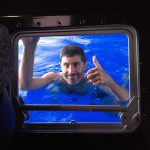

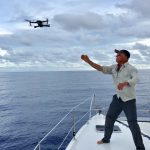
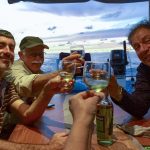

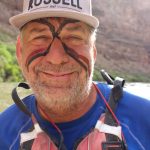
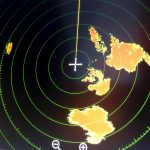
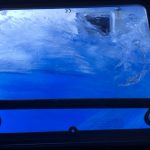
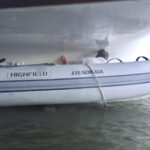
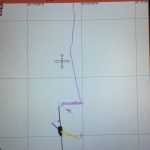

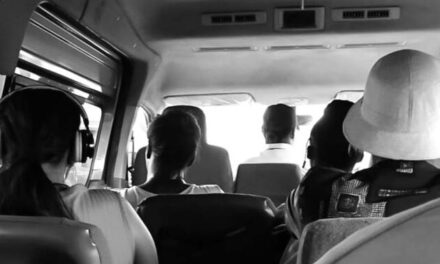
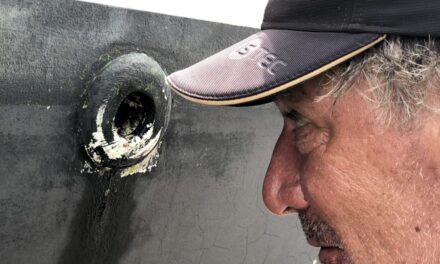
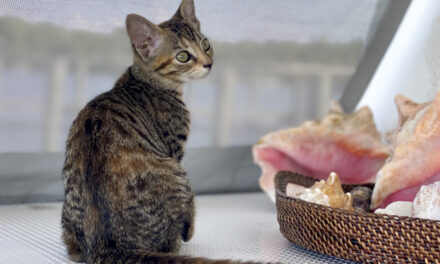
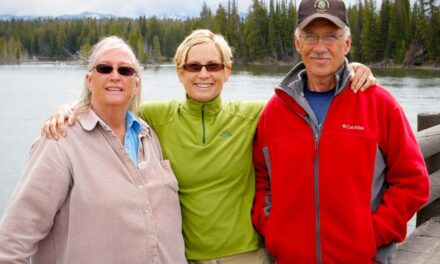


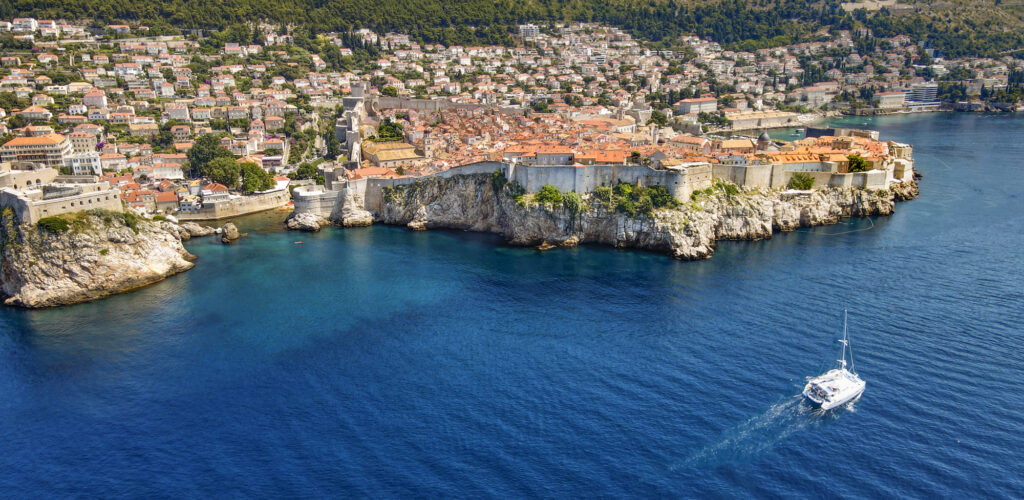
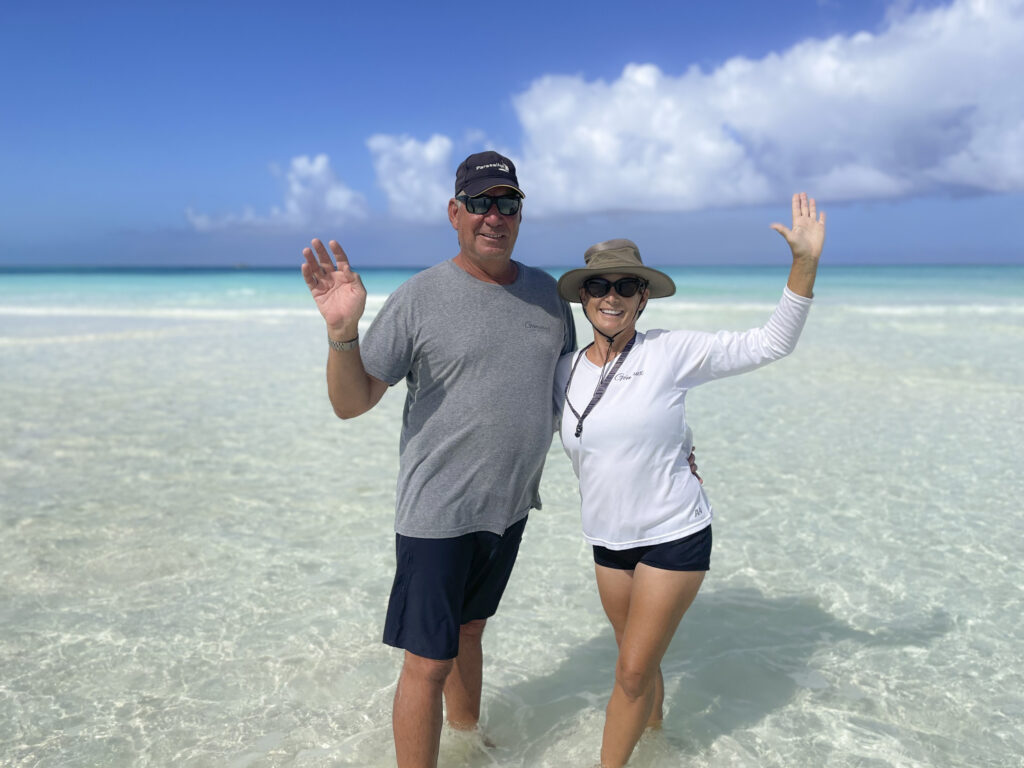
Trackbacks/Pingbacks